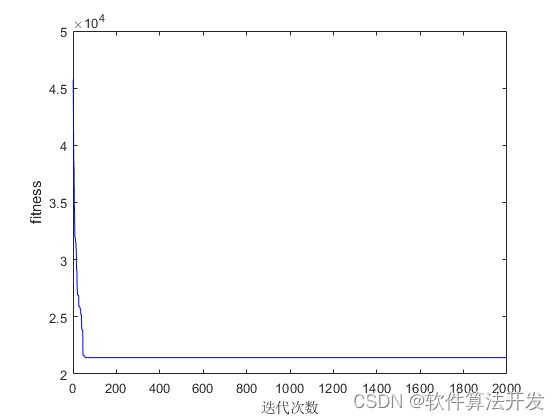目录
1.程序功能描述
旅行商问题(Travelling Salesman Problem, TSP)是一个经典的组合优化问题,其目标是在给定一组城市及其相互之间的距离情况下,寻找一条经过每个城市恰好一次且返回起点的最短回路。TSP因其NP完全性及广泛应用背景而备受关注。免疫算法(Immune Algorithm, IA),作为一种受生物免疫系统启发的演化计算方法,近年来被广泛应用于解决此类复杂优化问题。
2.测试软件版本以及运行结果展示
MATLAB2022a版本运行


3.核心程序
....................................................................
%循环迭代
% 输出最优解
%最优变量
ybest = ysort(:,1);
%最优值
Lbest = trace(end);
% 绘制最优路径图
figure
for i=1:Num-1
plot([city(ybest(i),1),city(ybest(i+1),1)],[city(ybest(i),2),city(ybest(i+1),2)],'-bs',...
'LineWidth',1,...
'MarkerSize',6,...
'MarkerEdgeColor','k',...
'MarkerFaceColor',[0.9,0.0,0.0]);
hold on;
end
plot([city(ybest(1),1)],[city(ybest(1),2)],'rs',...
'LineWidth',1,...
'MarkerSize',8,...
'MarkerEdgeColor','y',...
'MarkerFaceColor',[0.2,0.5,0.8]);
hold on;
plot([city(ybest(end),1)],[city(ybest(end),2)],'ks',...
'LineWidth',1,...
'MarkerSize',8,...
'MarkerEdgeColor','y',...
'MarkerFaceColor',[0.2,0.8,0.6]);
hold on;
title(['优化最短距离:',num2str(Lbest)]);
% 绘制迭代过程中最优路径长度随迭代次数的变化曲线
figure
plot(trace,'b-');
xlabel('迭代次数')
ylabel('fitness')
00404.本算法原理
4.1免疫算法概述
免疫算法模拟了生物免疫系统的运作机制,主要包括以下几个核心概念:
-
抗原(Antigen):在TSP中,抗原可以对应于待优化问题的解,如一条候选的城市访问路径。
-
抗体(Antibody):抗体是免疫系统针对特定抗原产生的识别与反应单元。在IA中,抗体表示为问题的可能解,即一条城市访问序列。抗体通常具有编码结构,以便于遗传操作和适应度评估。
-
免疫库(Repertoire):免疫库是存储抗体的集合,相当于演化算法中的种群。在TSP应用中,免疫库包含若干个不同的城市访问路径。
-
克隆选择(Clonal Selection):这是免疫系统的核心机制,通过复制高亲和力(适应度)的抗体来增强其在免疫库中的比例。在IA中,对应于选择优秀的抗体个体进行复制(克隆),以保持或增加它们在种群中的数量。
-
变异(Mutation):生物免疫系统中,抗体在克隆过程中会发生随机变异以增加多样性。在IA中,通过引入变异算子(如交换、逆序等)对克隆的抗体进行局部调整,生成新的解变种。
-
免疫记忆(Immune Memory):免疫系统能够记住先前遇到的抗原,以便快速响应再次出现的威胁。在IA中,这体现在保留历史最优解或精英个体,确保算法不会遗忘已发现的好解。
4.2免疫算法应用于TSP
将免疫算法应用于TSP求解时,关键步骤包括:
初始化:随机生成一个包含Npop个抗体(即城市访问序列)的免疫库,每个抗体由Num个整数构成,表示城市编号,且无重复。
适应度评估:对于每个抗体A_i,计算其对应的路径长度L(A_i),作为其适应度f(A_i)。在TSP中,适应度函数通常取反路径长度,即f(A_i) = 1 / L(A_i),以使优化目标与最大化适应度一致。路径长度L(A_i)通过以下公式计算:

其中,d(u, v)表示城市u和城市v之间的距离,从距离矩阵dist中获取。
克隆选择与变异:选择适应度较高的抗体进行克隆,然后对克隆体进行变异操作。变异可采用以下两种策略之一:

免疫记忆:记录当前迭代周期内找到的最优抗体A_best及其适应度f(A_best)。在后续迭代中,即使A_best未被选中进行克隆,也应将其保留在种群中。
迭代终止条件:当达到预设的最大迭代次数Niter或适应度改善阈值时,终止算法,并返回当前最优抗体A_best作为TSP问题的近似最优解。
5.完整程序
VVV
























 618
618











 被折叠的 条评论
为什么被折叠?
被折叠的 条评论
为什么被折叠?










